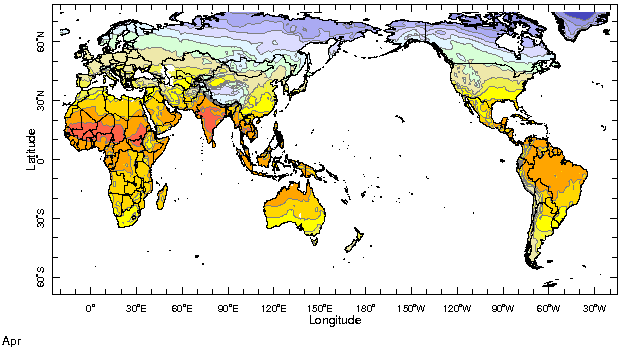|
IRI Climate Digest
May 2005
April Global Climate Summary
Climatological Background
In April, the sun's migration into the northern hemisphere has begun, bringing springtime to the northern mid-latitudes. The monsoon systems which still linger south of the equator will move northward following the solar heating of the continents in the next two months. In the southern hemisphere, fall has arrived, with cooler temperatures and a strengthening of the mid-latitude storm tracks.
Monthly Mean Temperature (1961-1990), data from the Climate Research
Unit, University of East Anglia


Monthly Mean Precipitation (1961-1990), data from the Climate Research
Unit, University of East Anglia


Temperatures
Highlights
Across the globe, most land areas experienced normal to above-normal temperatures during April. While temperature anomalies weakened in West Africa, compared to those during March, the continent largely saw temperatures on the order of 1-2°C above normal. Above-normal temperatures were also observed across most of Europe, with eastern and northern areas experiencing conditions 2-5°C warmer than during the previous month. The warm conditions seen in Central Asia during March shifted east during April, leaving near-normal temperatures in that region and above-average temperatures in portions of Kazakhstan, China, Mongolia and Russia. A similar movement of temperature regimes was seen in North America with relatively warm conditions in Alaska and western Canada shifting to cover most of northern North America during April. In South America, conditions cooled slightly during April, compared to those of the previous month. Temperatures there were generally near-normal with pockets of relatively warm and cool conditions in southern Brazil and northern Argentina, respectively. Temperatures in Australia, which exceeded 4°C above normal in some areas, exacerbated the dry conditions that have returned to that continent in recent months.
Temperature Difference from the 1961-1990 mean, with data
from NCEP Climate Prediction Center, CAMS.


Precipitation
Highlights
Precipitation was slightly below normal in northern and southwestern Europe during April, continuing the relatively dry conditions seen in those regions over recent months. Heavy rains, however, brought flooding to portions of eastern Europe during April. In Africa, above-average rainfall in the Ethiopian highlands and northern Somalia caused flooding in the Horn, while drier-than-normal conditions were observed across much of East Africa. Pockets of above-average rainfall were observed in southern Africa during April, which generally marks the end of the climatological rainy season in that region. Southeastern China experienced drier-than-normal conditions during April, as did western Indonesia and the Philippines, although some areas in eastern Indonesia saw above-average precipitation. Another dry month in Australia marked the second driest January-April period on record for the country, according to the Australian Bureau of Meteorology. In South America, relatively dry conditions continued to affect most of Brazil, southern Colombia and eastern Bolivia. Above-average rainfall was observed in Paraguay, Uruguay, and the northern tip of the continent during April.
Precipitation Difference from 1979-1995 mean, with data
from NCEP Climate Prediction Center, CAMS-OPI.


Oceanic Conditions
Negative sea surface temperature (SST) anomalies in the eastern equatorial Pacific at the beginning of the month were replaced by positive anomalies by the end of April. In the monthly average, ocean temperatures were slightly above normal across the central and western equatorial Pacific. See the ENSO Quick Look and the IRI ENSO Update for more information. Surface ocean temperatures were once again near to slightly above normal in the tropical Indian Ocean, and a large area of significantly above-average SSTs persisted in the tropical North Atlantic, as it has for several months. A tongue of cooler-than-normal conditions has developed along the equator off the west coast of Africa. In the extratropical North Atlantic and North Pacific, temperature anomalies changed only slightly between March and April. In the South Pacific Ocean an area of above-normal temperatures developed near 120°W, and negative anomalies centered on 90°E developed in the extratropical Indian Ocean.
Monthly Sea Surface Temperature Difference from the 1971-2000 mean,
with data from the Environmental Modeling Center, NCEP/NOAA.


Contents |
Special |
Impacts |
Climate |
Forecast
|

